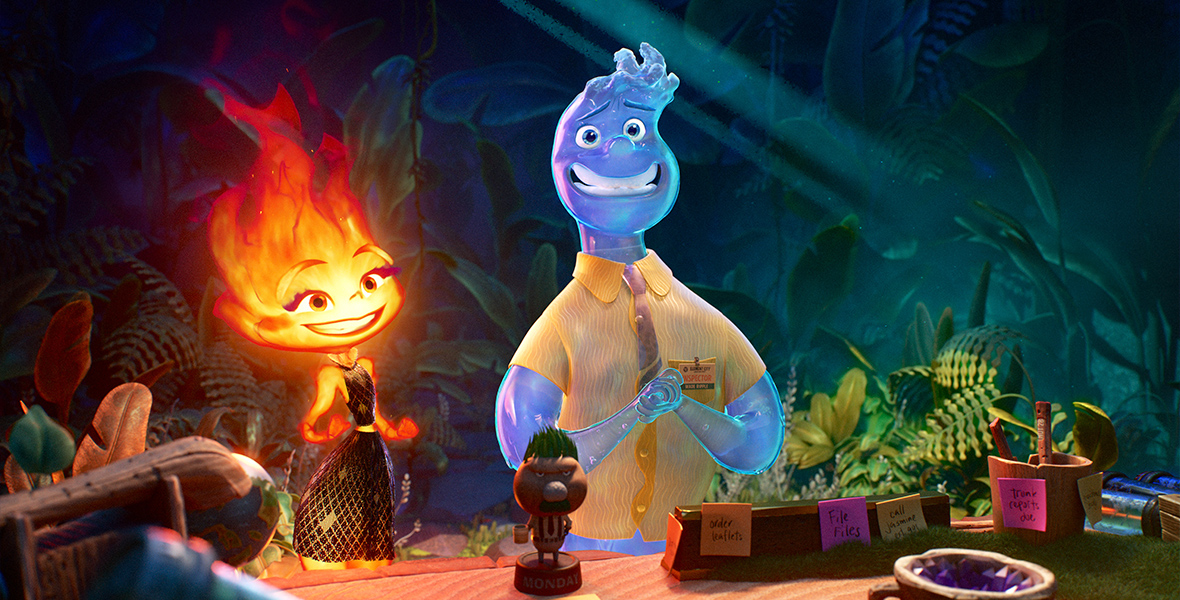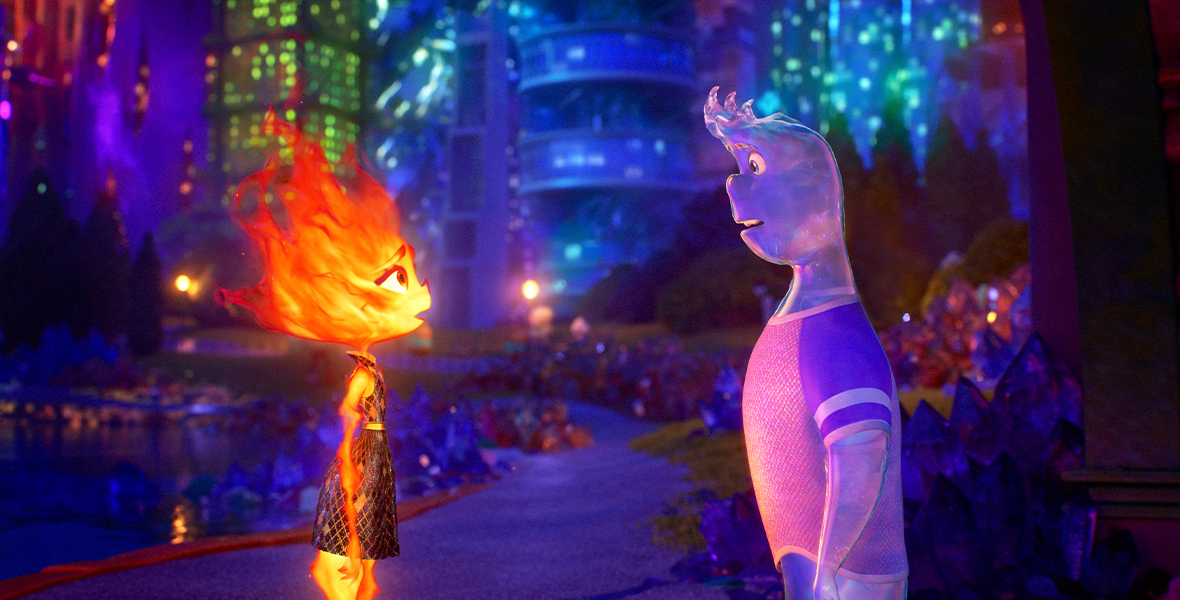By Bruce C. Steele
It’s time to start planning your journey to Element City, a place unlike any you’ve ever seen before and the setting for Disney and Pixar’s new animated feature, Elemental, opening June 16, only in theaters.
The thriving, colorful metropolis is home to interconnected communities of people made of the four elements of classical lore: water, fire, air, and earth. It’s also home to the recently arrived fire couple, Bernie and Cinder (voiced by Ronnie Del Carmen and Shila Ommi, respectively), and their Element City-born daughter, Ember (voiced by Leah Lewis). Bernie runs a bodega-like shop specializing in imports from Fireland and other fire-friendly products, and Ember is his eager apprentice—although her hot temper sometimes get in her way.
“I love Ember. I wish I was Ember,” says the film’s director, Peter Sohn, who also conceived the story’s setting. “I wish I had the strength that she has.”
Ember needs that strength to try to rescue the fire shop from closure, and she latches onto an unlikely source of assistance: water guy Wade (voiced by Mamoudou Athie), who one day splashes into her life. Their journey together—their gradual connection—is at the heart of the movie.
It’s a lot to absorb, so we’re here to give you the spark you need to find your way in this wonderous new land. Following are five key things to know in advance of seeing Elemental, as illuminated by Sohn and producer Denise Ream in a recent online press conference.
1. The story and characters were inspired, in part, by Sohn’s childhood in the Korean immigrant community in the Bronx in New York City.
“My parents came from another county,” shares Sohn, a Bronx native. “The shop they started, and a couple other shops that my father had started, were all in immigrant neighborhoods, so that’s all that I had known [while growing up].” For the film, he continues, “I was trying to capture that idea of people from other places who have gathered to create a life for themselves. That was the emotional hook for me, that my parents had come here from another place to make a better life for us.”
It was not an experience unique to Sohn, of course. “That personal experience resonated with a lot of people—our co-workers and colleagues,” Ream adds. “So many people at Pixar are first- and second-generation immigrants. We ended up having a lot of those people work on the movie, and that added texture and authenticity.”

2. The pairing of fire and water people as the main characters was, you might say, elemental.
“When I was first drawing these ideas out, it was just stream of consciousness—just drawing and connecting to different ideas,” Sohn explains. At one point, he says, “I was trying to figure out, ‘What would be really hard for fire?’ And then I drew a bunch of fire characters over water in a boat. Then from there, it was like, ‘Oh, what if there was a water person?’ When I drew a fire person next to a water person, there was an immediate tension of like, ‘Oh, that water person could put that fire character out.’ You couldn’t get the same tension between an earth character and an air character. Fire and water were just a very visual punch of opposites, but then also a conflict.”
Designing the final characters to embody that idea was less simple, Ream adds. Take Ember, for example: “From a design perspective, it [needed to be] very clear that this is not a person on fire. They were made of fire.” The same could be said of Wade, who has the fluidity of water in his every move.
3. Shaping the characters and story tapped into some very personal experiences.
Wade, whom Sohn likes to describe as a “go-with-the-flow guy,” is prone to tears at unexpected moments. “When you drew a water person, having them leak water and sweat or cry was just a funny visual,” he says. “In trying to find Wade as the story was evolving early on, there was something about it that I tied to [the fact that] I am a totally emotional guy. I’m a crier. I was just pulling from my own life.”
Some incidents in the film reflect not just Sohn’s life but those of others on the creative team. “We really [encouraged] our crew members to bring their personal stories into this,” the director says. An early sequence in which Bernie and Cinder, with baby Ember, are searching for an apartment, only to have many doors shut in their faces, “came from a real experience of this French story artist named Bolhem Bouchiba, who boarded this moment for us,” Sohn recalls.

4. The portrayal of Element City was inspired by many earlier live-action films.
The metropolis is chock-full of details viewers may need multiple viewings to appreciate, from the particular products in Bernie’s shop, to the signs and architecture that characterize the buildings in different neighborhoods, to the water-based mass transit system that poses a particular challenge for fire people. For inspiration on inventing an entire big city and making it appear, for the most part, lush and attractive, the Pixar creative team turned to the great filmmakers of the past.
“I really believe in this creation concept called ‘immaculate reality,’” Sohn explains. “It was a phrase that I heard from [Disney Legend] George Lucas on the making of Star Wars. They were designing things knowing that they had a [fictional] history. The audience would never get to know that history, but because of that, it would make the world feel more real.”
The Elemental team also looked at “how some of our favorite cities were shot” in classic films, Sohn continues. “For example, the way that Roman Holiday was shot to showcase moments of Rome… [and how for] Amelie they made this postcards version of Paris.” They were also inspired by how the late cinematographer Gordon Willis shot New York City for many classic films of the 1970s and 1980s. His work, Sohn says, “showcased the city as this person, and it was that sort of mentality that we were trying to find.”
5. The film’s rich backstory and sweeping visuals are in service of a simple theme.
“This was such a personal journey,” Sohn says, “about wanting to thank our parents for the sacrifices that they’ve made… [and to] connect to something that feels real and truthful and deep within ourselves—from kids to adults, families, and everybody.”
Ream adds that they are always “telling stories that come from a personal place at the studio.” And in this case, the location of that personal place is the fantastical Element City—which everyone will be able to visit at theaters starting on June 16.



